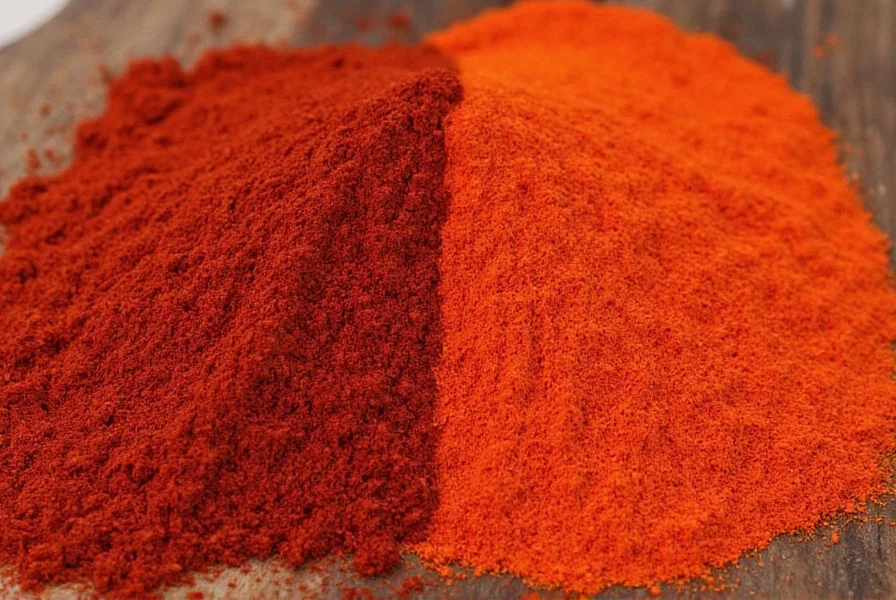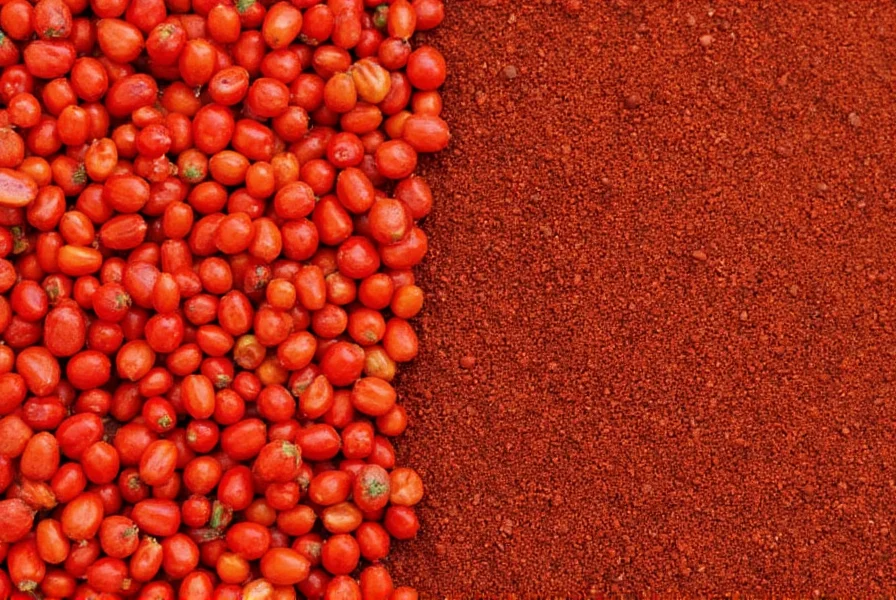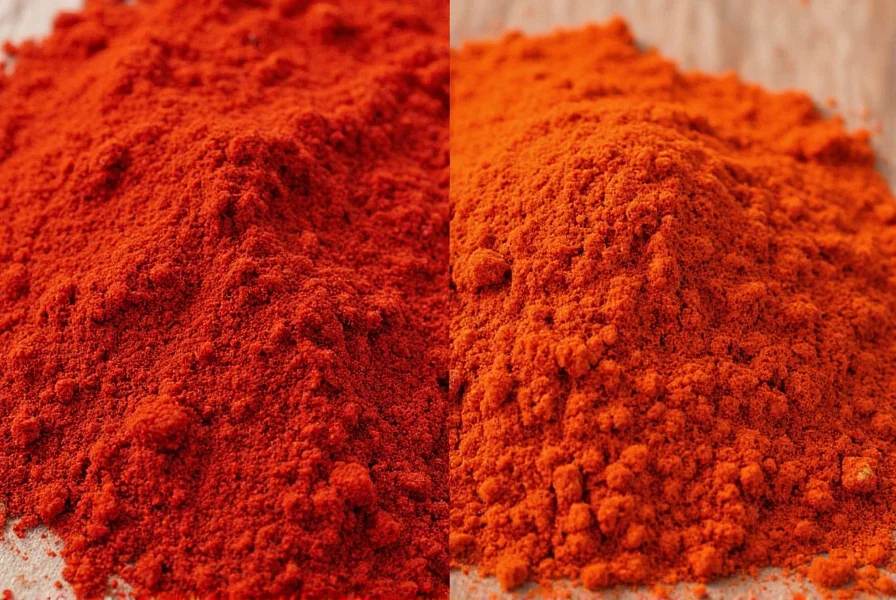No, smoked paprika and regular paprika are not the same. The key difference lies in their production process: smoked paprika is made by smoking dried peppers over oak wood for several weeks, giving it a distinctive smoky flavor, while regular paprika is simply ground dried peppers without the smoking process. This fundamental difference affects their flavor profiles, culinary uses, and even color intensity.
Understanding the distinction between these two popular spices is essential for home cooks and professional chefs alike. While both originate from ground dried peppers, their preparation methods create significantly different end products that serve unique purposes in the kitchen. Getting these spices confused can dramatically alter the flavor profile of your dishes.
What Exactly Is Paprika?
Paprika is a vibrant red spice made from grinding dried sweet or hot peppers belonging to the Capsicum annuum species. Originating in Central Mexico but popularized in Hungary, paprika ranges from mild and sweet to hot and pungent depending on the pepper varieties used. Traditional Hungarian paprika, considered the gold standard, comes in eight distinct varieties graded by color, heat, and flavor.
The production process for regular paprika involves harvesting ripe peppers, drying them either in the sun or using mechanical dryers, and then grinding them into a fine powder. This straightforward process preserves the natural pepper flavor without additional processing. The resulting spice offers a sweet, slightly fruity taste with varying heat levels depending on the specific pepper cultivar.
The Unique Production of Smoked Paprika
Smoked paprika, known as pimentón in Spain where it originated, undergoes an additional critical step that transforms its character. After harvesting, the peppers (typically larger varieties like ónra or jarra) are smoked for one to three weeks over oak wood fires in special drying houses called secaderos. This traditional smoking process imparts the distinctive smoky flavor that defines this spice.
The smoking duration determines the intensity of the smokiness, with some varieties receiving only a light smoke while others develop a deeply smoky character. Spanish smoked paprika comes in three main varieties: dulce (sweet/mild), agridulce (bittersweet), and picante (spicy). This regional variation adds another layer of complexity to understanding the difference between smoked paprika and regular paprika.
| Characteristic | Regular Paprika | Smoked Paprika |
|---|---|---|
| Production Method | Dried peppers ground into powder | Peppers smoked over wood then ground |
| Flavor Profile | Sweet, earthy, slightly fruity | Pronounced smoky with varying heat levels |
| Color | Bright red to deep orange-red | Rustic red to deep brick red |
| Primary Origin | Hungary | Spain |
| Best Culinary Uses | Goulash, deviled eggs, potato salad | Paella, chorizo, roasted vegetables, barbecue |
Flavor Comparison: Understanding the Taste Differences
When considering can I substitute smoked paprika for paprika, understanding their flavor profiles is crucial. Regular paprika offers a clean pepper flavor that ranges from sweet to hot without additional notes. Hungarian sweet paprika provides a pure pepper taste with subtle fruitiness, while hot varieties deliver straightforward heat.
Smoked paprika, by contrast, introduces a complex smoky dimension that can range from subtle to intense. The flavor of smoked paprika often resembles the taste of bacon or campfire smoke, making it a powerful flavoring agent. Even sweet smoked paprika (pimentón dulce) carries this distinctive smokiness that regular paprika completely lacks.
One common misconception is whether smoked paprika is hotter than regular paprika. Heat level and smokiness are separate characteristics. Smoked paprika comes in sweet, medium, and hot varieties, just like regular paprika. The smoking process doesn't inherently make the spice hotter—it simply adds smokiness.
Culinary Applications: When to Use Each Spice
Understanding when to use smoked paprika vs regular paprika can elevate your cooking from good to exceptional. Regular paprika shines in dishes where you want pure pepper flavor without competing elements:
- Hungarian goulash and other traditional Central European dishes
- Deviled eggs and potato salads
- As a colorful garnish for soups and dips
- In rubs for poultry where you want pepper flavor without smoke
Smoked paprika excels in recipes that benefit from its distinctive smoky character:
- Spanish paella and other rice dishes
- Chorizo and other smoked sausages
- Barbecue rubs and sauces
- Roasted vegetables, especially potatoes and eggplant
- Bean dishes like chili for added depth
Professional chefs often keep both varieties on hand because they serve different purposes. As one chef explains: "Regular paprika is like a blank canvas of pepper flavor, while smoked paprika is a finished painting with distinct smoky notes. You wouldn't use watercolor over an oil painting—that's how different they are."

Substitution Guidelines: Can You Swap Them?
The question of can I substitute smoked paprika for paprika (or vice versa) depends entirely on your recipe and desired outcome. In most cases, these spices are not directly interchangeable without altering your dish's flavor profile.
If a recipe calls for regular paprika and you only have smoked:
- Use half the amount of smoked paprika to avoid overwhelming the dish with smoke flavor
- Consider adding a pinch of cayenne if you need more heat without additional smoke
- Best for heartier dishes like stews, chili, or roasted meats where smoke complements other flavors
If a recipe calls for smoked paprika and you only have regular:
- Add a few drops of liquid smoke (use sparingly—start with 1/8 teaspoon)
- Consider adding a small amount of chipotle powder for both heat and smokiness
- Best for dishes where smoke isn't the dominant flavor note
For the most authentic results, however, using the specific paprika called for in the recipe yields the best outcome. This is particularly true for traditional dishes like Spanish paella (which requires smoked paprika) or Hungarian goulash (which relies on sweet Hungarian paprika).
Regional Variations and Quality Considerations
Not all paprikas are created equal. Understanding regional differences helps you select the right product for your needs:
- Hungarian paprika: Considered the benchmark for quality, with eight official varieties ranging from mild édesnövesztő to fiery erős. Look for "Hungarian" or "Magyar" on the label.
- Spanish pimentón: Always smoked, with three main varieties—dulce (sweet), agridulce (bittersweet), and picante (spicy). Protected by PDO status for certain regions.
- American paprika: Often milder and less complex than European varieties, frequently used as a coloring agent rather than for flavor.
When purchasing either spice, look for vibrant color and check the harvest date if possible. Paprika loses potency over time, so fresher is better. Store both varieties in airtight containers away from light and heat to preserve their flavor compounds.

Practical Tips for Cooking with Both Spices
To maximize the flavor potential of both paprika varieties, consider these professional tips:
- Bloom spices in oil: Heat paprika in a small amount of oil for 30-60 seconds before adding other ingredients to release maximum flavor
- Avoid high heat: Both spices can become bitter if burned, so add them toward the end of cooking for delicate dishes
- Balance acidity: A small splash of vinegar or citrus can brighten dishes featuring either paprika variety
- Pair with complementary flavors: Regular paprika works well with sour cream and caraway; smoked paprika pairs beautifully with garlic, cumin, and tomatoes
Understanding these nuances in paprika vs smoked paprika taste comparison allows you to make informed decisions in your cooking. The choice between these spices isn't about which is better—it's about selecting the right tool for your culinary task.
Conclusion: Making the Right Choice for Your Dish
While both spices share the name "paprika," their differences are significant enough that they shouldn't be considered interchangeable in most recipes. Regular paprika provides pure pepper flavor, while smoked paprika delivers that essential smoky dimension that can't be replicated with regular paprika alone.
Building a well-stocked spice cabinet with both varieties gives you maximum flexibility in the kitchen. When following recipes, pay close attention to which type is specified, as this detail often makes the difference between an authentic-tasting dish and one that misses the mark. Whether you're making traditional Hungarian goulash or Spanish paella, using the correct paprika variety ensures your dish achieves its intended flavor profile.
Can I use smoked paprika instead of regular paprika in deviled eggs?
While possible, substituting smoked paprika for regular in deviled eggs significantly changes the flavor profile. Traditional deviled eggs rely on the clean pepper flavor of regular paprika. If you use smoked paprika, the eggs will have a distinct smoky taste that may not appeal to all palates. For best results, use regular paprika as called for in classic deviled egg recipes.
Does smoked paprika have more heat than regular paprika?
No, heat level and smokiness are separate characteristics. Both regular and smoked paprika come in sweet, medium, and hot varieties. The smoking process adds smoky flavor but doesn't inherently increase heat. Check the label for terms like "dulce" (sweet), "agridulce" (bittersweet), or "picante" (spicy) to determine heat level regardless of whether it's smoked or regular.
How long does paprika last before losing flavor?
Paprika typically maintains peak flavor for 1-2 years when stored properly in an airtight container away from light and heat. After this time, it gradually loses potency and vibrant color. To test freshness, rub a small amount between your fingers and smell it—fresh paprika should have a strong, characteristic aroma. If the scent is weak or musty, it's time to replace your spice.
What's the best way to store paprika to maintain freshness?
Store both regular and smoked paprika in airtight glass or metal containers away from direct light, heat, and moisture. The ideal storage location is a cool, dark cupboard. Avoid storing spices above the stove or near other heat sources. For longest shelf life, consider dividing larger quantities into smaller containers, keeping one in use and storing the rest in the freezer where paprika can maintain flavor for up to 3 years.
Can I make my own smoked paprika at home?
Yes, though it requires specific equipment. To make smoked paprika at home, you'll need fresh peppers (like bell peppers or New Mexico chiles), a smoker, and a dehydrator. Smoke the peppers at 200°F for 3-6 hours depending on desired smokiness, then dehydrate until completely dry before grinding into powder. The process takes several days but allows you to control the intensity of smoke to your preference.











 浙公网安备
33010002000092号
浙公网安备
33010002000092号 浙B2-20120091-4
浙B2-20120091-4